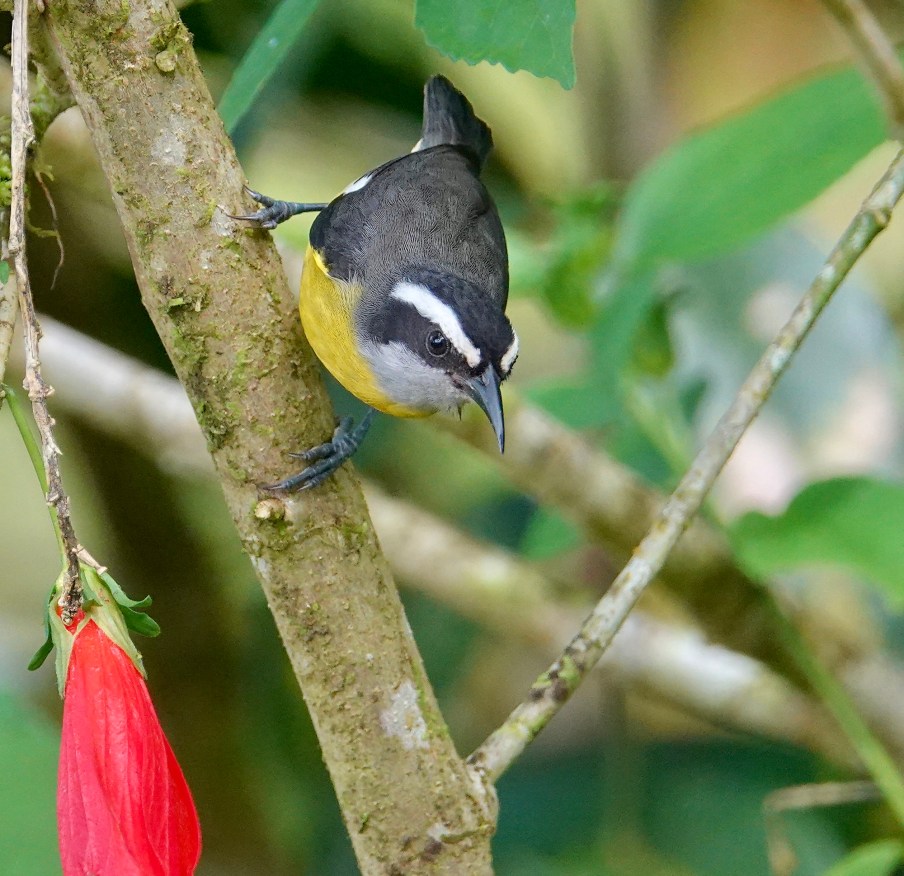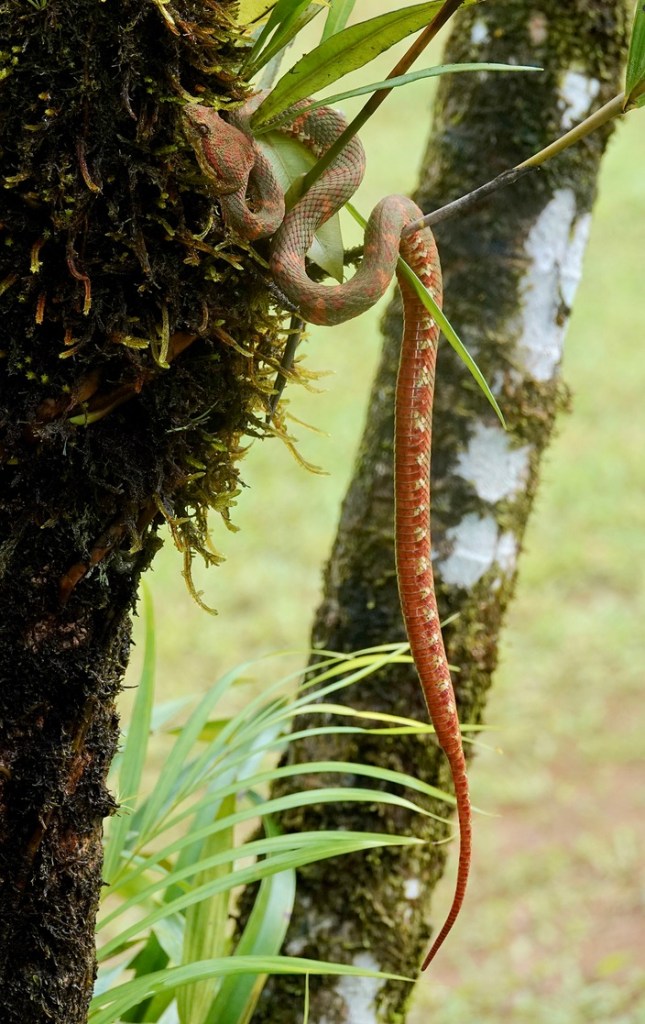Posts in Category: Costa Rica
Golden-naped Woodpecker
Golden-naped Woodpecker: Las Tardes Community Ecology Project, Corcovado National Park, Osa Peninsula, Costa Rica, December 2022— This is from the road above the Las Tardes project. The Golden-naped Woodpecker is “near-endemic” of Costa Rica…only found in the south Pacific lowlands and foothills and just barely into Panama across the border. This is a female…the males have a small patch of red on the crown. Sony Rx10iv at 600mm equivalent. Program mode with my custom birds and wildlife modifications. Processed in Pixelmator Photo and Apple Photos. ISO 100 @ f4.5 @ 1/1000th.
Bright-rumpled Attila

Bright-rumpled Attila: Las Tardes Ecological Project, Corcovado National Park, Osa Peninsula, Costa Rica — My only excuse for this photo is that this very common bird of the Central American tropics is also very hard to see…the field guides say “more often herd than seen.” Not a great photograph, but it does show the bright rump that gives the bird its name, and the hooked beak that gives it its character! Sony Rx10iv at 600mm equivalent. Program mode with my custom birds and wildlife modifications. Processed in Pixelmator Pro and Apple Photos. (I had to dig the bird out of the shadows and it is a heavy crop.) ISO 100 @ f4 @ 1/500th.
Bananaquit

Bananaquit: Las Tardes Community Ecology Project, Corcovado National Park, Osa Peninsula, Costa Rica, December 2022 — The Bananaquit has long complicated story. It was placed with the new world warblers, or the sparrows (buntings), or maybe in a genus of its own…before genetic profiling put it with the tanagers, in the same sub-family as Darwin’s Finches. It is a wide-spread bird all through Central and South America and the Caribbean, occasionally reaching extreme South-Florida in the US. It has an unusual amount of variation over its range, with island birds in particular, being quite different looking than those found on the continents. It has 41 (41!) recognized sub-species, at least a few of which are already on track to be split into species of their own. So, no, not a simple bird, though common all through the American tropics. It eats nectar and fruit and can be seen around dwelling with gardens. It will come to bananas at feeders. Sony Rx10iv at 600mm equivalent. Program mode with my custom birds and wildlife modifications. Processed in Pixelmator Photo and Apple Photos. ISO 800 @ f4 @ 1/500th.
Eyelash Pit Viper


Eyelash Pit Viper: Las Tardes Community Ecology Project, Corcovado National Park, Osa Penninsula, Costa Rica — As I mentioned in a previous post, because of high water and damaged roads up the river channel we could not take our normal tractor and trailer ride up the Recon River into Corcovado National Park, so we drove into the Las Tardes Community Ecology Project at the edge of the park. One of their projects is snake relocation. They pay local farmers to bring the snakes they encounter in their fields to them, rather than just killing them, and then, after keeping them a few days to make sure they are healthy, they relocate them deep in the park. On any given day they may have several venomous snakes ready for relocation. They brought out two Eyelash Pit Vipers for us to see and photograph: one the bright yellow we associate with the species, and this one which is quite different in color. It turns out that Eyelash Pit Vipers come in a variety of colors…and there can be any number of colors in a single hatch of eggs. Sony Rx10iv at 600 and 192mm equivalents. Program mode with my custom birds and wildlife modifications. Processed in Pixelmator Photo and Apple Photos. ISO 1600 and 400 @ f4 @ 1/500th and 1/400th.
Mottled Owl

Mottled Owl: Hotel Bougainvillea, San Jose, Costa Rica, December 2022 — I posed a photo of this owl taken my first afternoon in Costa Rica. This is the next morning in better light. 🙂 I have seen several owls, over the years in this same stand of bamboo on the hotel grounds. Sony Rx10 iv at 561mm equivalent. Program mode with my custom birds and wildlife modifications and multi-frame noise reduction. Processed in Pixelmator Pro on the Macbook Air. Equivalent ISO 6400 @ f4 @ 1/500th.
Blue-vented Hummingbird
Blue-vented Hummingbird: Bougainvilla Hotel, San Jose, Costa Rica, December 2022 — It was before sun-up when we met to bird the gardens at the Bouganvilla on the first morning of our trip to Costa Rica this year, and this was pretty much the first bird we encountered. The Blue-vented Hummingbird (formerly Steely-vented Hummingbird) is a common hummer of the dry north-west of the country that just makes it up into the central valley…so the Bouganvilla was the only place we were going to see it on this trip. 🙂 It is a small, energetic hummer that feeds from a variety of flowers. Sony Rx10iv at 517mm equivalent. Program mode with my custom birds and wildlife modifications, and multi-frame noise reduction. Processed in Pixelmator Photo and Apple Photos. Equivalent ISOs 1600, 3200, and 1250 @ f4 @ 1/500th.
Lesson’s Motmot

Lesson’s Motmot: Hotel Bougainvilla, San Jose, Costa Rica, December 2022 — The most common and widespread Motmot in Costa Rica is the Lesson’s, formerly called the Blue Crowned Motmot. This one was there to greet us in gardens of the Hotel Bougainvilla on the slope overlooking San Jose. Early morning light. Sony Rx10iv at 600mm equivalent. Program mode with my custom birds and wildlife modifications and multi-frame noise reduction. Processed in Pixelmator Photo and Apple Photos. Equivalent ISO 2500 @ f4 @ 1/500th.
Lesser Violetear making ears at me!
Lesser Violetear Hummingbird, Batsu Gardens, San Gerardo de Dota, Costa Rica, December 2022 — As I said yesterday, this used to be the Green Violetear until the species was split into the Mexican and the Lesser Violetear. I don’t quite get the Lesser…since there is no Greater, and the Mexican and Lesser are exactly the same average size??? The mysteries of bird names are many. This posture is an aggressive or defensive pose…with the ears flared out…and is generally only seen in confrontations between two Violetears. There was another Violetear hovering…after the same perch. Sony Rx10iv at 586mm equivalent. Program mode with my custom birds and wildlife modifications and multi-frame noise reduction. Processed in Pixelmator Photo and Apple Photos. Equivalent ISO 1250 @ f4 @ 1/500th.
Lesser Violetear and White-throated Mountain-gem

Lesser Violetear and White-throated Mountain-gem: Batsu Gardens, San Gerardo de Dota, Costa Rica, December 2022 — As I mentioned it was a missy, mostly cloudy afternoon at Batsu Gardens and Marino put out flowers for us to photograph the hummingbirds. This is two of the classic high country hummers of Central America: the Lesser Violetear and the White-throated Mountain-gem. The Lesser Violetear used to be the Green Violetear before it was split, pretty much at the northern border of Costa Rica, with the birds north now called Mexican Violetear. The Lesser ranges to the edges of South America. (And, no, there is no Greater Violetear.) The White-throated Mountain-gem is even more confused. It is endemic to the Talamanca Mountains and higher volcanos of Costa Rica and Panama, but some authorities consider the Panama birds to be the Grey-tailed Mountain-gem, a separate species endemic to Panama. Whatever! Still both attractive hummers of the high mountains. Sony Rx10iv at 493mm equivalent. Program mode with my custom birds and wildlife modifications. Processed in Pixelmator Photo and Apple Photos. ISO 2000 @ f4 @ 1/500th.
Fiery-throated Hummingbird

Fiery-throated Hummingbird: Paradiso Quetzales Lodge, Costa Rica, December 2022 — Yup. This is what a Fiery-throated Hummingbird looks like when the sun hits it just right. For some reason the Fiery-throats insisted on perching on the deck and wire railings rather than all the nice natural perches provided…but still it is one amazing hummingbird. Sony Rx10iv at 586mm equivalent. Program mode with my custom birds and wildlife modifications. Processed in Pixelmator Photo and Apple Photos. ISO 500 @ f4 @ 1/500th.






